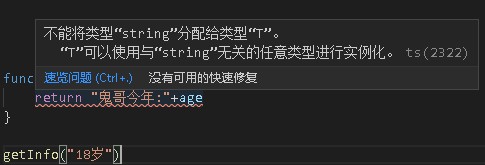Six of TypeScript's re-aware knowledge points
May 31, 2021 Article blog
Table of contents
The article comes from the public number: Frontman Author: Ghost Brother
This article will be written because in the technology group there are small partners in the discussion, put forward the need to improve the understanding of TypeScript, this article will cover a few TypeScript common and difficult to understand a few points of knowledge, simple use of their own official website documents!
Several important concepts in Typescript
1.The difference between any and T (generic).
/**
any 和 T ,一个是任意类型,一个是泛类型
卧槽,这也太难让人理解他的区别了吧,字面意思几乎一样,
但是我连续读了:泛..泛.泛 任意..任意类型,读了十遍,还是感受到了差异
*/
any:任意类型,代表的是所有类型
泛型:泛型他就是所有类型中的一种类型,并不是完全的所有类型,所以在函数中返回的类型要和定义的类型一摸一摸,不能修改他原有的类型
// 在这种场景下,有区别体现
//正确
function getInfo(age: any): any {
return "鬼哥今年:"+age
}
getInfo("18岁")
//错误
function getInfo(age: T): T {
return "鬼哥今年:"+age
}
getInfo("18岁")
//这里直接报错

2.type interface enum
-
typeUsed to constrain data types (data structures, data properties and can be union types, tuple types)
-
interfaceUsed to constrain data types (data structures, data properties and cannot be union types, tuple types)
-
enumThe value used to constrain the data type, not the data type
Use scenarios such as:
//人
interface People {
}
//动物
interface Animal {
}
// type和interface区别1
// 正确(人既可以是动物,也可以是人)
type User=People | Animal;
// 错误(人既可以是动物,也可以是人),使用interface定义却是不可以的
interface User { People | Animal };
其实从语法上可以看出他们两的区别,`type` 是用`=`符号,既然是等于,那肯定就存在多种情况的,`interface`使用的是`{}`符号,是一种`定义`的形式,既然是`定义`,那肯定就是觉得性质的,只会有一种可能
/**************************************/
// type和interface区别2
既然`interface`是一种数据结构,那肯定是可以实现这种数据结构的,所以`interface`可以实现的功能
// 比如运用interface用来定义接口,然后实现接口的功能:
interface UserModelApi {
getUserList:()=>Promise,
getOrderList:()=>Promise,
}
class HtppApi implements UserModelApi{
getUserList(){
return new Promise((resolve)=>{
});
}
getOrderList(){
return new Promise(()=>{
});
}
}
// enum和const的区别
/**
他们两者的相同点,都是定义数据,
且定义的数据不可更改.不同点在于
1)其实和上面描述`type`与`interface`一样,
他们都是一个是定义,一个是赋值
2)下面的代码是不是从感觉使用枚举看上去语法的阅读性更强
3)`enum`枚举可以用来定义类型
*/
// 正确(语法理解上一看就知道,是这个对象有哪种情况)
enum Sex { M = "男", F = "女" }
// `enum` Sex枚举可以用来定义类型
const getInfo=function(sex:Sex){
return `我的性别为:${sex}`;
}
/**************************************/
// 错误(而这种语法看上去就是,这个对象有哪些值)
const Sex ={
M:"男",
F:"女"
}
// `const` Sex 不可以用来定义类型
const getInfo=function(sex:Sex){
return `我的性别为:${sex}`;
}
3. Map type
Convert a type in an object or array to another type
// 假设一个系统账号登录的场景:
//定义一个用户信息的接口类型
interface User {
age: number
name: string
password:string
}
//登录成功设置用户数据
const UserInfo:User={
age:1,
name: "鬼哥",
password:"123456"
}
//输出密码为:123456
console.log(UserInfo.password)
//此时当设置用户数据成功后,User接口定义就不能再修改了,那我们就可以使用`映射类型`
//设置所有属性为只读
* keyof:获取当前对象所有属性{"age" | "name" | "password"}
* T:泛型
* P: 当前属性
type SetReadonly ={
readonly [P in keyof T]:T[P];
}
//新建只读用户数据对象
type ReadonlyUser = SetReadonly;
const UserInfo:ReadonlyUser={
age:1,
name: "鬼哥",
password:"123456"
}
//直接报错,因为UserInfo实力中的每个属性都不可以修改
console.log(UserInfo.password)
//当然这样的举例说服我们去使用确实还缺少一些说服力,但是他的场景就是:在定义类型之后,可以重新设置定义类型的属性值
4. Cross type
/**
意思其实就是,共同的意思(数学中的并集的概念)
这个和extends功能上相差不大,但是extends如果是类的话需要调用父函数构造函数
大致使用如下:
*/
interface UserApi {
getOrderList():void
}
// extends方式
interface AppApi extends UserApi {
getUserList():void
}
const appApi:AppApi={
getOrderList(){
},
getUserList(){
}
}
//交叉类型方式
const appApi:AppApi&UserApi={
getOrderList(){
},
getUserList(){
}
}
5. Union type
/**
意思其实就是,相同部分的意思(数学中的交集的概念)
*/
interface UserApi {
getUserList():void
}
interface AppApi{
getUserList():void
}
//联合类型方式
const appApi:AppApi|AppApi={
getUserList(){
}
}
6. Tuple
/**
这个从字面上就很好理解
元:元素(代码里就是对象的意思)
组:数组
所以意思就是:一个包含多个类型对象的数组集合,这个不要想太多就是这么个东西
*/
type regionType={
province:string,
city:string
}
const region:regionType={
province:"上海省",
city:"上海市"
}
const tableList = ["鬼哥",15,region];
Here's a look at
W3Cschool编程狮
introduction to
the six re-aware knowledge points in TypeScript
that I hope will help you.